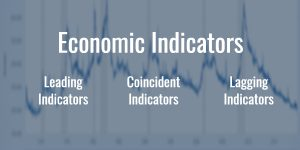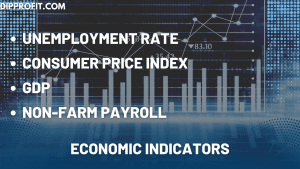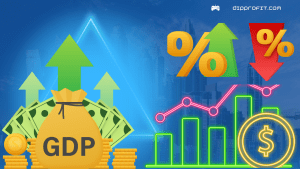Forex Economic Indicators
Forex Economic indicators are indicators that are used in getting information about the current state of the economy, confirming the current state of the economy, and finally predicting the future state of the economy.
All around the world at various times governmental and non-governmental institutions give reports that contain several economic information and the methods in which these reports are gathered and collated vary considerably.
Economic indicators can be divided into three (3) categories, namely:
Lagging indicator
Indicators under this category confirm economic occurrences that have already happened. Which is why they are called lagging indicators.
Coincident Indicators
Economics indicators under this category are able to tell us about the current economic situation, helping us understand what to trade in and what not to trade in at the moment.
Leading Indicators
These are the most effective type of indicators and they are of particular interest to traders as they help the trader understand the trajectory of future economic activities.
Every one of the economic indicators falls into one of the above-mentioned categories and they have their uses and benefits.
In the currency market today, be it the forex market, CFD’s market, the Cryptocurrency market, and so on, the main challenge faced by beginner forex traders is understanding how economic indicators work, how to interpret the economic information these indicators present, the most important indicators that directly impact the market and how to use the information presented by these indicators to their advantage.
This information is very important as every single day economic data/indicators are released on the economic calendar but not all are relevant and as much as it is important to keep track of these economic events on the calendar, it is more important to understand the economic indicators to look out for and how they directly affect the market.
Therefore in this article, we would be helping you understand 4 important Forex economic indicators that are always likely to have a very strong effect on the financial market, and how to interpret data from these economic indicators when their information is released on the economic calendar.
As the US economy is arguably the largest and most influential economy in the world the list of economic indicators we would be giving would be on the US reports. As also in forex / CFD’s trading most of the pairs are with the USD which shows how the US economy has a large influence on the financial market.
Finally, before we kick start with the list, there are two basic points that are very important in analyzing information from the economic indicators, we have talked about it in one of the articles titled: 10 Factors that affect fundamental analysis and Increase Forex Traders Profitability. These factors are:
Read Also: 7 Candlestick Patterns Every Trader Should Know
Percentage Change in Economic Data
You must know that what determines the effect the economic indicator data would have on the financial market is not the Data itself but the percentage change in the data. What this means is the percentage difference between the previous economic data and the one just released recently is one of the factors that would directly affect the market.
So we can have a poor value for last month and the value is still poor this month, but have serious volatility in the market due to the percentage change/difference. You can read this article to understand more about this.
Market Expectation
The second factor is even more important and that is the market expectations. On the economic calendar, economic data are always given out as market forecasts, before the real economic indicators values are released. These market forecasts are what the economist, financial experts, and analysts are expecting from the market.
Therefore, if the economic data is afterward released and they are totally different from the general market expectations. There would be high volatility in the market and price would fluctuate greatly, but if the economic data released is similar to the market expectations, then it would have little to no effect on the financial market, however important the indicator is.
Read Also: How to Trade Like a Pro Using SMC Trading Strategy
4 Key Forex Economic Indicators
The following are the four (4) major economic indicators in the financial market.
- Unemployment Rate
- Consumer Price Index (C.P.I)
- Gross Domestic Product (G.D.P)
- Non-Farm Payroll (N.F.P)
Unemployment Rate
This economic indicator is used to determine the percentage of individuals who are in the labor force bracket but don’t have jobs and are actively looking for work. In periods of economic recovery, the unemployment rate can be said to be a lagging indicator.
As we have said already, looking at the calendar, two pieces of data should be of interest one is the analysts’ and traders’ forecast and percentage change in the FED data from the previous data.
A higher-than-expected reading should be taken as negative/bearish for the USD, while a lower-than-expected reading should be taken as positive/bullish for the USD.
Consumer Price Index (C.P.I)
The Core Consumer Price Index (CPI) measures the changes in the price of goods and services, excluding food and energy. The CPI measures price change from the perspective of the consumer. It is a key way to measure changes in purchasing trends and inflation.
If inflation is within target standards, it is considered normal or even desirable. However, if inflation veers too far off these standards for a long time, it can have very negative effects on the economy. Therefore the FEDs take this data seriously also.
Note the prices increase when inflation is on the rise and vice versa.
In the case of the C.P.I, a higher than expected percentage reading should be taken as positive/bullish for the USD, while a lower than expected reading should be taken as negative/bearish for the USD.
Gross Domestic Product (GDP)
GDP is the widest degree of the general fitness of an economic system. It takes a long term to bring together its data and that is why its direct impact on the Forex market and CFD costs is regularly muted – and by the time the statistics are published, a few of the information and data are already known, and, therefore, expectancies are regularly pretty accurate. That being said, if the data released varies from the expectancies, then there would be a major move in the financial market.
Also despite its lack of timeliness, it’s still a very important economic indicator because it gives economists and analysts and also the FED a detailed insight into where the country is in the business circle. The business circle consists of the expansion period and the retraction period.
The period of expansion is when the economy is booming and growth is steady, while the retraction period is the period in which the economy is in recession. As should be known, the GDP is used to measure the level of economic activities occurring in a country.
The GDP can be said to be a lagging indicator as it is only used to confirm what we already know most of the time.
When the GDP data is released the Usual Effect it has on the economy can be understood as follows, if the Actual is greater than the Forecast, then it’s good for the currency which means a bullish bias, but if the Actual data is lower than the Forecast made by traders, economist, and market analyst, it depicts a bearish bias.
Frequency: Released monthly. There are 3 versions of GDP released a month apart – Advance, the second release, and the Final. Both the advance and the second release are tagged as preliminary in the economic calendar.
Non-Farm Payroll (NFP)
The non-farm payroll is one of the economic indicators that always has an immediate and visible major impact on the financial market among the list we have mentioned.
The Nonfarm Payrolls measure the change in the number of people employed during the previous month, excluding the farming industry. Job creation is the foremost indicator of consumer spending, which accounts for the majority of economic activity.
This is similar to the GDP explained earlier, but the difference is that while the Non-Farm Payroll data is released monthly the GDP data is released quarterly and the delay is what causes, the limited effect it shows on the financial market.
A higher-than-expected reading should be taken as positive/bullish for the USD, while a lower-than-expected reading should be taken as negative/bearish for the USD.
Part of being a professional forex trader is knowing and understanding the forex market, what drives the price actions you see on your charts when carrying out your technical analysis, and how to use the information provided by the economic indicators to your advantage n the market.
We hope this article has been able to enlighten you a little on some of the fundamental aspects of forex trading and the financial market.
You can look up the economic indicators using the economic calendar, which can be done on the following website: investing.com and forexfactory.com.








